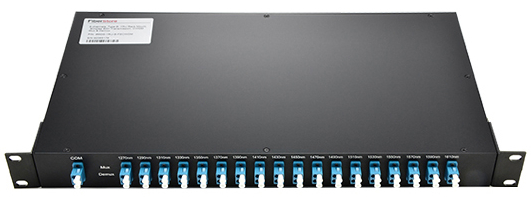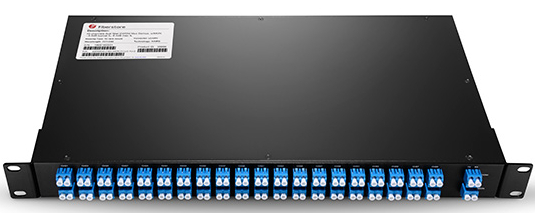Wavelength division multiplexing (WDM) system is designed for high capacity communications. It is now frequently used as a method to merge multiple optical signals with different wavelengths onto a single fiber. There are two divisions of WDM system: coarse wavelength division multiplexing (CWDM) and dense wavelength division multiplexing (DWDM). Using WDM can enhance the effectiveness of bandwidth in fiber optic communications. The WDM Mux/Demux has a number of communication channels, and matches with a certain frequency. Wavelengths are separated to different receivers at the destination. Mux/Demux module is an important assembly using WDM technology. This article will introduce some effective CWDM and DWDM Mux/Demux solutions for WDM system.
CWDM Mux/Demux is a flexible network solution for WDM optical networks. At most 18 full-duplex wavelengths can be added over a single fiber trunk which greatly alleviates fiber exhaustion. With low insertion loss and high stability, CWDM Mux/Demux is applied to many operations, such as CATV links, WDM systems, test and measurement, metro and access networks, FTTH networks, etc. The deployment of CWDM Mux/Demux is transparent and clear. Its compact form factor enables a much easier manipulation. Only coarse wavelengths can be transmitted over the fiber which reduces the WDM system cost.
Three kinds of CWDM Mux/Demux are widely used in the application. They are 1RU 19″ rack chassis CWDM Mux/Demux, half 19″/1RU CWDM Mux/Demux and splice/pigtailed CWDM Mux/Demux. CWDM Mux/Demux in 19 inch rack mount package is often used for CWDM, EPON and CATV network. Half 19″/1RU CWDM Mux/Demux is packed in LGX box using thing film coating and non-flux metal bonding micro optics packaging. Splice/pigtailed CWDM Mux/Demux is packed in the ABS box package based on standard thin film filter (TFF) technology.
DWDM Mux/Demux conveys optical signals in a more dense wavelength. It is especially used for long distance transmission where wavelengths are highly-packed together. The maximum delivered wavelengths can reach up to 48 channels in 100GHz grid (0.8nm) and 96 channels in 50GHz grid (0.4nm). DWDM Mux/Demux uses a reliable passive WDM technology that achieves low insertion loss. And it provides a solution for adding WDM technology to any existing network device. Applications like point-to-point DWDM fiber optimization, linear add/drop DWDM fiber optimization, external optical monitoring are typically using DWDM Mux/Demux module.
Likewise, 1RU 19″ rack chassis DWDM Mux/Demux, Half 19″/1RU DWDM Mux/Demux and splice/pigtailed DWDM Mux/Demux are three divisions of DWDM Mux/Demux modules. The first type is in 19 inch rack mount package used for long-haul transmission over C-band range of wavelengths. The second one is in LGX package used for PDH, SDH/SONET, Ethernet services transmission. The last one is in ABS box package and its pigtails are labeled with wavelengths.
18-CH CWDM Mux/Demux is a highly recommended 1RU rack-mount CWDM Mux/Demux that combines 18 CWDM sources on a single fiber. The insertion loss is below 4.9 dB. Moreover, it has a monitor port that enables maintenance without ceasing the operation.

40-CH DWDM Mux/Demux has 40 channels. As a DWDM Mux/Demux module with high density, low-loss and independent 1RU rack mount package, the best utilization of this device is to employ it for high density applications over long-haul transmission. It multiplexes and demultiplexes 40 DWDM wavelengths with 100 GHz in a ring or point-point network. It is a highly cost-effective DWDM Mux/Demux module.

To improve the efficiency of network transmission, WDM technology is often deployed in the devices. 18-CH CWDM Mux/Demux and 40-CH DWDM Mux/Demux are now recommended as the most cost-effective WDM solutions with expanded fiber capabilities. Hope you can choose and use them wisely.

